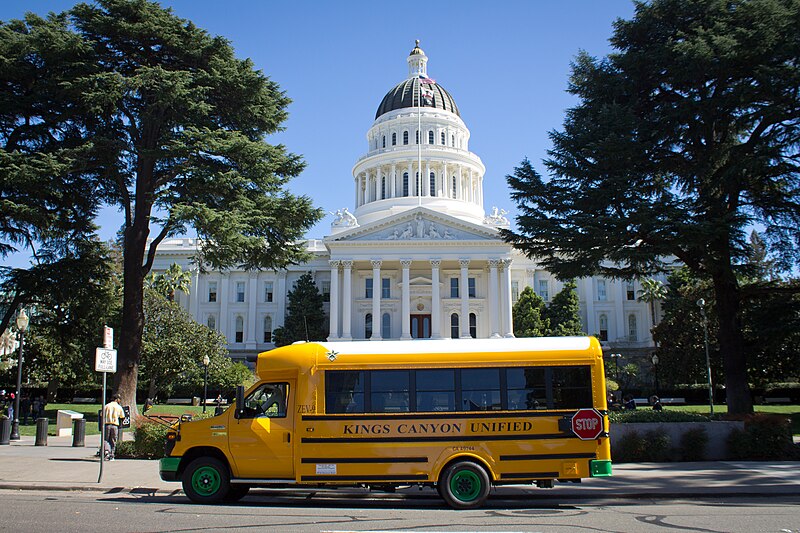It will take a long time to electrify the nation's bus fleet. But a new study says the right mix of financing measures and government subsidies could supercharge the nation's school bus fleet within the decade.
As the logistical challenges of electrifying the nation's city bus fleets continues to stymie transit agencies, a the new U.S. Public Interest Research Group report reveals that the electric school transportation vehicles, with their comparatively simple schedules and routes, are actually "ready to roll" right now — if districts can just solve the problem of how to pay for what would be a game-changer for our national climate outlook.
By some measures, the school bus industry actually represents the largest mass transit program in the U.S., boasting 480,000 vehicles that are responsible for 10 billion students trips every single year. (By contrast, Americans take about 9.9 billion trips per year on the grown-up public transportation system, but that includes all vehicle types, not just buses.) But that impressive yellow fleet is notoriously dirty; fewer than 0.6 percent of school buses run on clean power, and 95 percent of them run on diesel, which is associated with increased rates of cancer, respiratory illnesses, cardiovascular disease, and even deficits in academic performance.
Greening all those yellow buses would do more than just decrease pollution-related health disparities that are responsible for one in five deaths every year worldwide. It'd also avert 5.3 million tons of greenhouse gas emissions each year — the equivalent of removing about 1.2 million gas-powered passenger cars from the road.
"We shouldn't be putting the health of our kids at risk when we don't have to," said Matt Casale, Environment Campaigns Director for USPIRG. "Electric school buses will help clean the air our kids breath and help reduce climate emissions, which represent an existential threat to all of our futures."
There are financial reasons to go green, too. Casale and his colleagues note that switching to an electric bus can actually save their operators as much as $130,000 in fuel and maintenance costs over the course of each vehicle's average 16-year lifetime.
But the up-front costs are steep: the average "green" bus costs $312,600, compared to just $110,000 for diesel — and the charging infrastructure it takes to power them all doesn't come cheap, either. To meet the challenge, USPIRG says governments and utility companies must pitch in.
On the government side, electric school buses have already gotten traction as an area of rare bipartisan consensus, both because poisoning children with diesel exhaust isn't exactly a winning political strategy, and because electrifying the fleet will likely create a lot of American jobs.
"It has to be remembered that as the US and Canada constitute the sole global markets for these dedicated yellow buses, they are nearly all manufactured on-shore," analyst Ruben Scriven noted in a recent article for Electric and Hybrid Vehicle Technology. "Large-scale production of these vehicles would not only create thousands of jobs, but could attract other electric vehicle component suppliers to invest in the United States, thereby making the entire automotive sector better able to compete for the fast-growing zero-emission vehicle market."
To juice that emerging industry, the federal government is already stepping up to offer programs like the Low-or-No Emissions grants program, the Congestion Mitigation and Air Quality Improvement program, and the State of Good Repair program, all of which can be used to subsidize electric bus adoption. Those typically aren't available to school districts directly, but programs like the School Bus Rebate Program are, and other legislation is pending; before she signed on to be Biden's Veep, then-Sen. Kamala Harris introduced the Clean School Bus Act, which if passed, would allocate $1 billion towards a nationwide Clean School Bus Grant Program.
A patchwork of state incentives exist, too, and advocates should push for more of them. But the report authors caution that government assistance alone "programs have not, and will not, be enough to support large-scale adoption."

Fortunately, utility companies have a major opportunity to help electrify the school transportation sector — and major financial incentives to do it.
"Electric utilities have a lot to gain from the large-scale adoption of electric school buses, and could play a major role in supporting the transition," the report notes. "Electric buses can expand and stabilize the grid, provide surplus energy storage, and increase energy demand."
One way that electric companies can help save the planet is to offer school districts a novel financing method called "Pay As You Save," which allows them to spread the costs of their new whips across several years. Because switching buses from gas to electric will boost utility revenues over time, USPIRG argues, they should front districts the additional costs of going green and adding charging infrastructure to depots, and then allow them to gradually repay that amount through their utility bill over the lifespan of the bus.
Schools can even expedite that repayment process by, essentially, using their buses as giant batteries when they're not in use, and selling intermittently available forms of clean power, like solar, back to the grid at times of peak demand. One study of such a "vehicle-to-grid" model in California found that each bus could generate more than $6,000 per year by storing and sending extra electricity back to the utility.
By engaging utility companies to think outside the box, and taking advantage of every available government grant program, school districts could put electric buses in their depots far sooner than they might think — and they should, because we don't have time to waste.
"We should be taking an all-hands-on-deck approach to getting these zero tailpipe emission buses on the road," said Casale. "That means school districts, policy makers and utilities all need to be working together to accelerate the transition away from diesel and toward a cleaner, healthier America."






